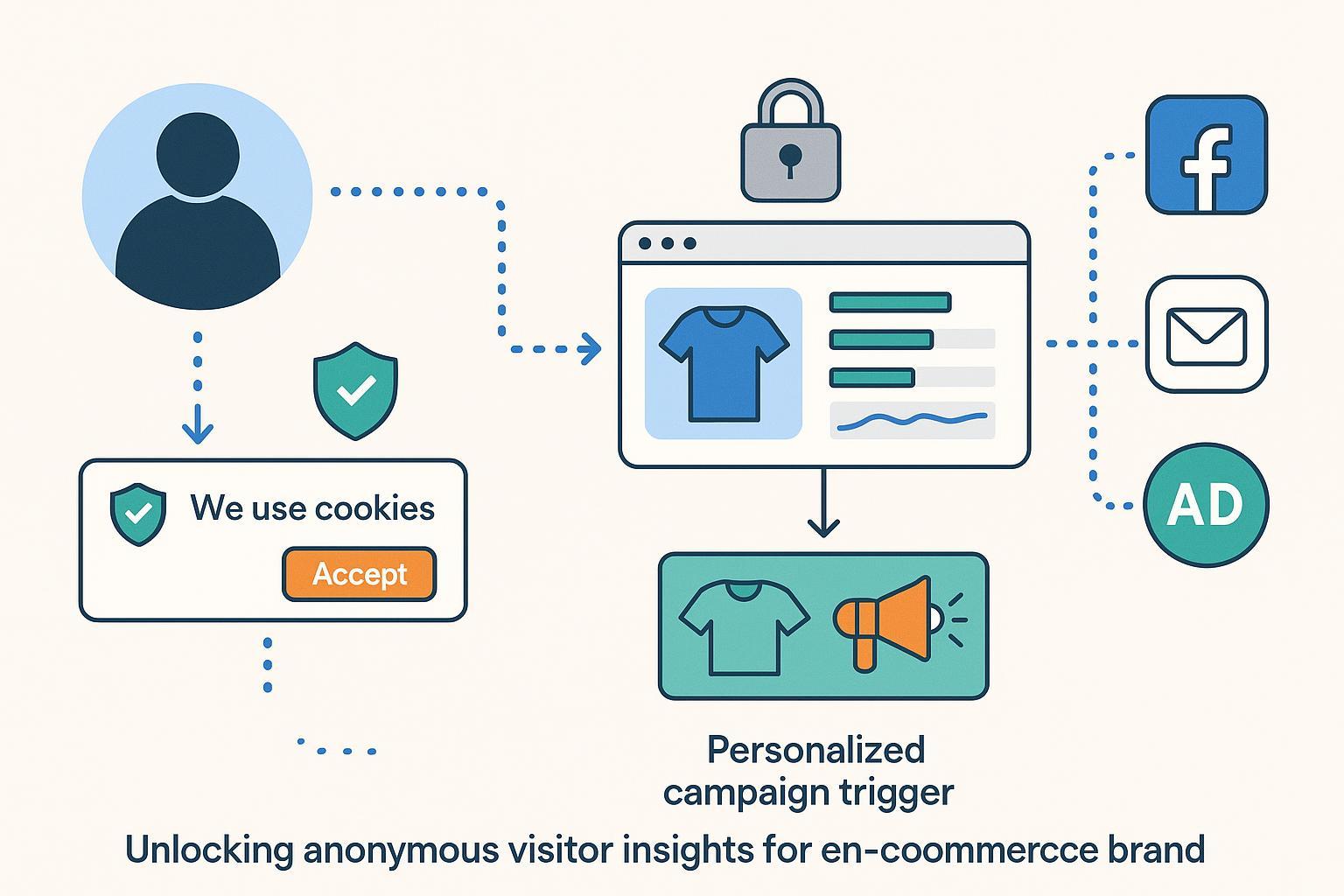Unlocking Insights: How to Identify Anonymous Website Visitors for Better Engagement (2024 Guide)

Why Identifying Anonymous Website Visitors is a Game-Changer in 2024
If you’re an e-commerce or DTC marketer, you know that the majority of your web traffic never logs in or fills out a form. These anonymous visitors are pure potential: They browse, add items to carts, and interact—yet most leave without a trace. Identifying and engaging these users isn’t just cutting-edge, it’s essential for maximizing ROI, retargeting efficiently, and boosting conversions.
- Fact: Known customers spend 3x more than anonymous ones. (Source: Shopify)
- Benchmark: Brands that convert more visitors from anonymous to known see a 10–22% uplift in engagement and a 15% bump in attributed revenue (CustomerLabs).
This guide gives you a step-by-step, immediately actionable roadmap—drawn from the latest 2024 best practices—for turning “unknowns” into your next best customers while staying compliant and customer-friendly.
The Step-by-Step Roadmap: Turning Anonymous Into Actionable Engagement
1. Lay the Technical Foundation: Privacy-First Tracking
Time: 15 minutes (Shopify or plug-and-play tools)
- Install a privacy-friendly analytics/tracking solution: Use platforms like Attribuly for Shopify/WooCommerce, or alternatives like Piwik PRO for broader platforms.
- Deploy session-based, first-party cookies: Ensure cookies are only used after user consent to remain GDPR/CCPA compliant.
- Integrate with main ad channels: Connect your solution to Google, Meta, TikTok, and Bing (Attribuly does this out-of-the-box).
- Quick check: Visit your site in incognito mode. Are only essential cookies loaded before consent? If not, review your setup.
Common Pitfall:
Over-relying on third-party scripts can break tracking due to browser restrictions—stick to first-party, server-side tracking when possible.
2. Launch Progressive Consent and Data Capture
Time: 20–30 minutes
- Create a value-driven consent banner (see template below). Go beyond the generic. Offer something in return for extended tracking—exclusive discount, free guide, or early access.
- Deploy a robust Consent Management Platform (CMP) such as OneTrust, Cookiebot, or your platform’s built-in solution (see Pandectes for Shopify).
- Test across all devices and browsers to ensure the banner is visible and functional for every visitor.
Consent Banner Template:
We value your privacy. Our website uses cookies and similar technologies to enhance your experience, analyze traffic, and personalize content. By clicking “Accept All,” you consent to these technologies. [Cookie Settings] | [Privacy Policy].
Checklist:
- [ ] Banner doesn’t block site usability
- [ ] Consent log retained for compliance
- [ ] Users can change their preferences anytime
Troubleshooting: If bounce rates spike after installing your CMP, check for banner overload or unclear messaging.
3. Engage Behavioral Analytics and First-Party Identity Collection
Time: 20–40 minutes (initial setup)
- Integrate behavioral analytics tools for granular tracking: Attribuly captures on-site interactions (pages, add-to-cart, time-on-site, etc.) and connects behaviors to anonymous profiles.
- Leverage UTM parameters and ad click IDs (like fbclid) to enhance attribution.
- Set up behavioral segmentation: Group visitors by traffic source, onsite actions, or device types. Use built-in segmentation in Attribuly, Shopify Analytics, or CustomerLabs.
- Automate micro-engagements: Use triggers such as exit intent popups, personalized recommendations, or time-delayed offers to incentivize identification.
Expert Tip: In my experience, simple exit popups timed after 90 seconds boost email capture rates by up to 15%.
4. Identity Resolution: Connecting Anonymous Data to Known Profiles
Time: 25–45 minutes
- Stitch anonymous & known user data together: Once a site visitor submits any identifier (email, phone, social login), match historical anonymous sessions with the new profile.
- Attribuly’s method: Leverage server-side tracking and Shopify’s Web Pixel to unify visitor paths—capturing both pre- and post-identification data for smarter retargeting.
- Integrate with your CRM or CDP to share resolved identities and enable multi-channel automation.
Verification:
- [ ] New sign-ups or purchases appear both in analytics and your marketing automation tool.
- [ ] Visitor journey from “anonymous” to “identified” is visible in Attribuly or your chosen analytics platform.
Troubleshooting:
- If matching fails, double-check your consent settings and UTM parameter capture.
- Some browser extensions may block scripts—test with a range of browsers and disable blockers during setup.
5. Segmentation & Engagement: Activate Targeted Campaigns
Time: 30–60 minutes for campaign setup
- Segment your now-identified users: By channel, behavior (e.g., abandoned cart, category viewed), device, and acquisition source.
- Attribuly lets you instantly build smart segments and sync them with Shopify, Klaviyo, Google Ads, and more for omnichannel activation.
- Activate personalized outreach: Trigger email flows, targeted ads, or messaging based on segment entry events (abandoned cart, VIP activity, etc.).
- A/B test retargeting and personalized offers to maximize engagement rates.
Real Example: A Shopify brand using Attribuly saw a 30% lift in cart recovery by identifying more visitors and triggering segmented WhatsApp/SMS flows.
6. Validate, Monitor, and Optimize
Ongoing: 10 minutes/week
- Run test journeys as an incognito visitor—see if you’re captured, segmented, and eventually engaged.
- Review/report on attribution accuracy (Attribuly’s benchmarks: ~85% attribution accuracy, 10–15% conversion lift).
- Iterate your campaigns and consent prompts based on analytics feedback, engagement rates, and new privacy regulations.
Tool Comparison: Best Solutions for E-commerce & DTC Brands (2024)
| Tool | Strengths | Best For |
|---|---|---|
| Attribuly | Multi-touch attribution, segmentation, AI, Shopify + major ad platform integration, automated campaigns | E-commerce attribution, Shopify, advanced segmentation |
| Leadfeeder | IP/company lookup, B2B enrichment | Wholesale/B2B/DTC blend |
| Knock Knock | Shopify-native pop-ups, easy install | Simple lead capture |
| HockeyStack | Event journey mapping, technical analytics | High-growth DTC |
| Albacross | Intent data, firmographics | B2B/DTC hybrid |
Pro Tip: For advanced segmentation, automation, and omni-channel syncing in e-commerce, Attribuly leads in effectiveness and ease of integration.
Privacy, Compliance & Consent: What Marketers Must Get Right
Checklist for 2024:
- [ ] All tracking starts only after explicit opt-in
- [ ] Transparent privacy policy and cookie notice
- [ ] Consent logs maintained and exportable
- [ ] Users can change or withdraw consent at any time
- [ ] Data is encrypted and not retained longer than necessary
- [ ] Audit third-party scripts and vendor updates regularly
Resource Links:
Common Mistake: Misconfigured banners or lack of opt-out can lead to hefty fines; always test your compliance setup before launch!
Troubleshooting & Common Pitfalls: Real-World Q&A
Q: My analytics show fewer tracked visitors than before. What’s wrong?
A: Likely, your new consent banner is stricter (a good thing). Verify all tags trigger only after real opt-in; check your tracking pixel placement and test in multiple browsers.
Q: Visitor journeys don’t connect after identity resolution.
A: Double-check that UTM parameters and ad click IDs are being passed and stored throughout the session; review your integration between analytics tool and CRM/CDP.
Q: Consent rates are low.
A: Test different banner placements/language or add a small incentive (like a discount code) for users who opt-in to personalized tracking/offers.
Mini Case Study: Shopify Brand Boosts Revenue With Anonymous Visitor Identification
A fast-growing DTC skincare brand struggled with abandoned carts and under-attributed Facebook ad spend. By installing Attribuly’s code-free Shopify integration, they:
- Upgraded to server-side, privacy-first tracking (took <20 minutes)
- Launched a dynamic consent pop-up with a 12% improved opt-in rate
- Used Attribuly’s AI segmentation to trigger automated SMS/WhatsApp flows for “warm” anonymous visitors
- Result: 30% lift in cart recovery in the first six weeks and a 15% increase in total attributed revenue
Your Next Step: From "Anonymous" to Loyal Customer—Faster
Unlocking the value of your anonymous traffic isn’t reserved for tech giants. With the right toolkit and workflow, e-commerce and DTC brands can win more engaged, high-LTV customers in 2024—without sacrificing privacy or compliance.
Ready to move from theory to practice? Explore how Attribuly can take the guesswork out of identity resolution, segmentation, and revenue attribution—no engineering required.
Questions, challenges, or success stories? Let’s keep learning and growing together for the best year in e-commerce yet!
References & Further Reading:
